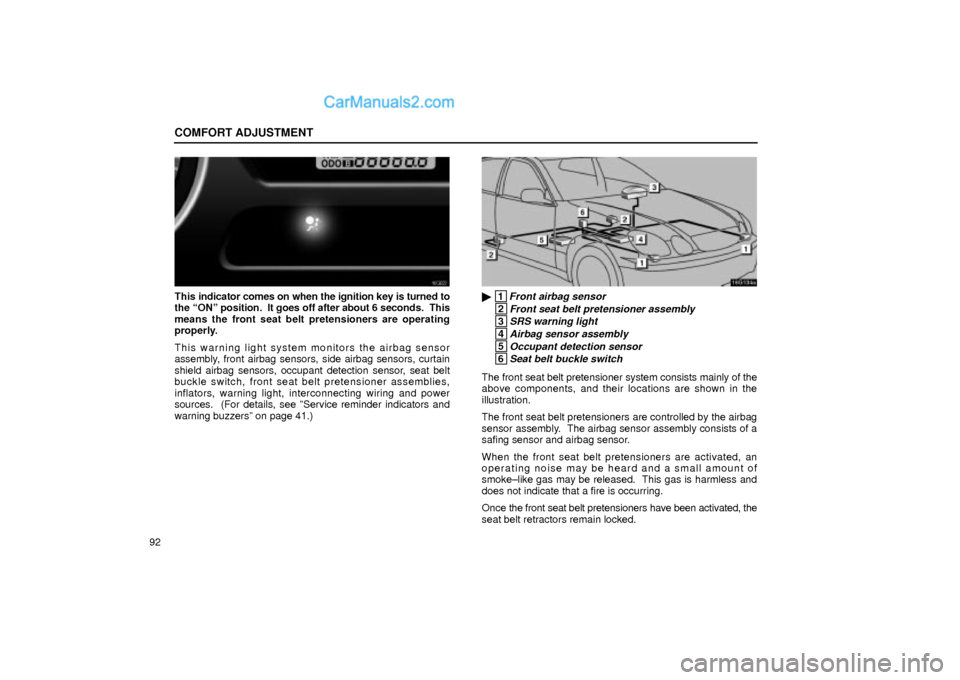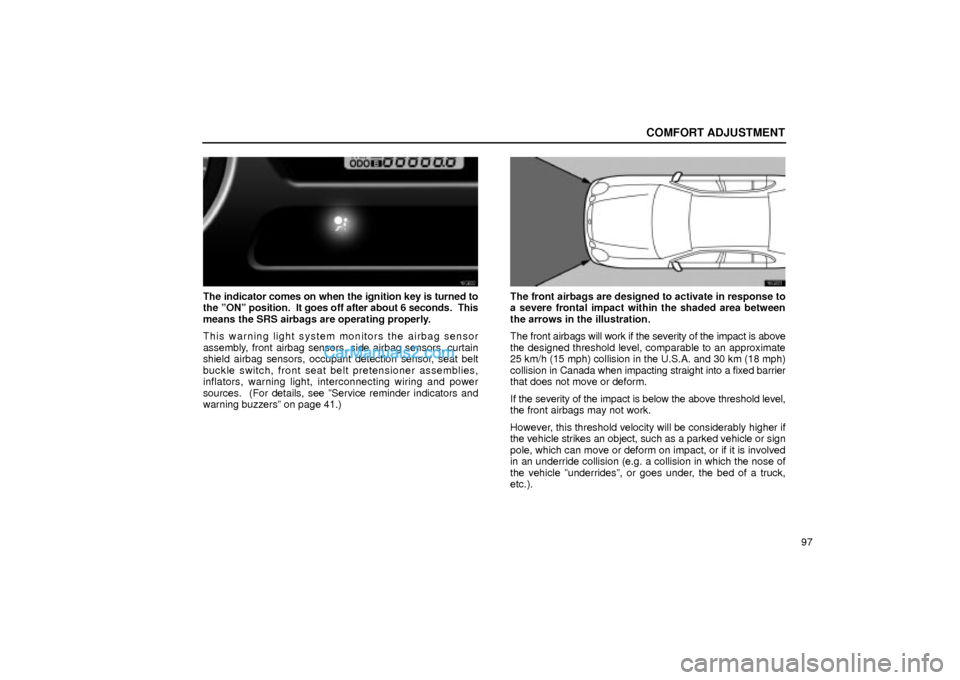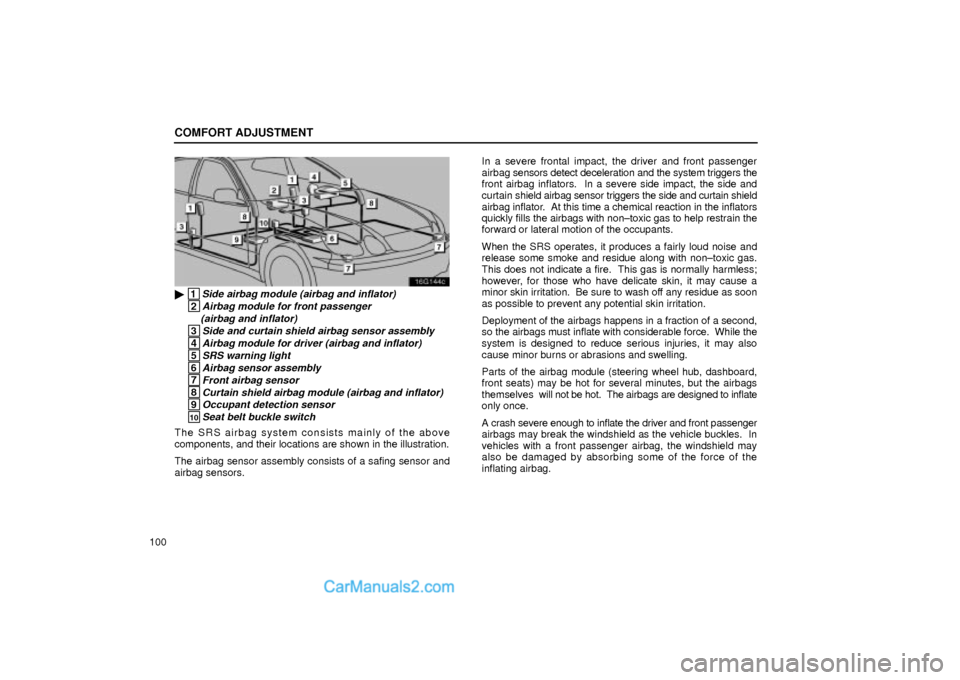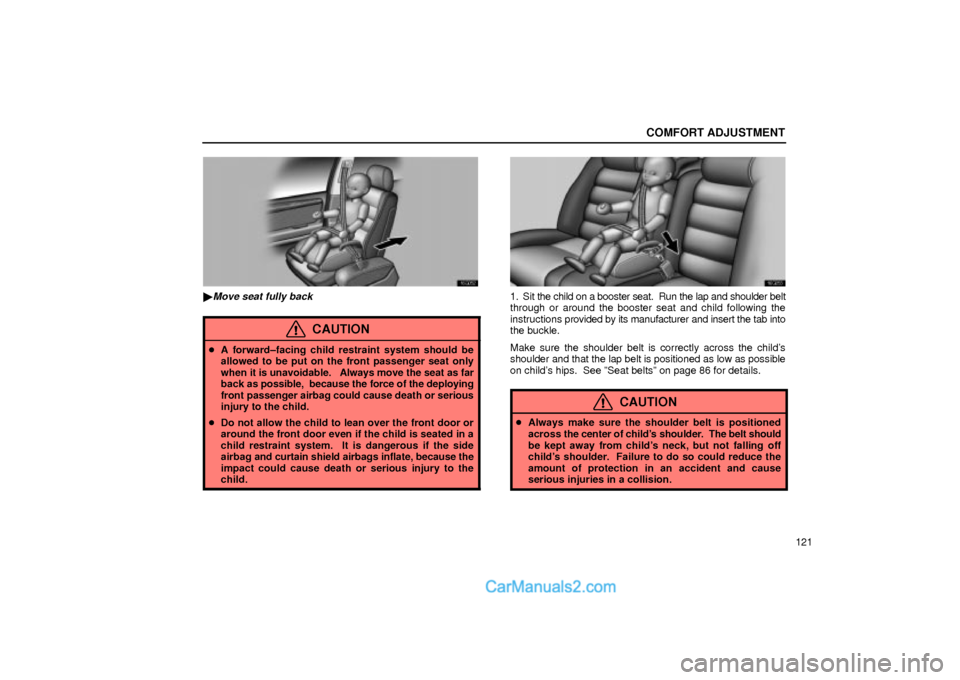Page 20 of 56

COMFORT ADJUSTMENT
92
16G022
This indicator comes on when the ignition key is turned to
the ªONº position. It goes off after about 6 seconds. This
means the front seat belt pretensioners are operating
properly.
This warning light system monitors the airbag sensor
assembly, front airbag sensors, side airbag sensors, curtain
shield airbag sensors, occupant detection sensor, seat belt
buckle switch, front seat belt pretensioner assemblies,
inflators, warning light, interconnecting wiring and power
sources. (For details, see ºService reminder indicators and
warning buzzersº on page 41.)
16G134a
� 1Front airbag sensor
2Front seat belt pretensioner assembly
3SRS warning light
4Airbag sensor assembly
5Occupant detection sensor
6Seat belt buckle switch
The front seat belt pretensioner system consists mainly of the
above components, and their locations are shown in the
illustration.
The front seat belt pretensioners are controlled by the airbag
sensor assembly. The airbag sensor assembly consists of a
safing sensor and airbag sensor.
When the front seat belt pretensioners are activated, an
operating noise may be heard and a small amount of
smoke±like gas may be released. This gas is harmless and
does not indicate that a fire is occurring.
Once the front seat belt pretensioners have been activated, the
seat belt retractors remain locked.
Page 25 of 56

COMFORT ADJUSTMENT
97
16G022
The indicator comes on when the ignition key is turned to
the ºONº position. It goes off after about 6 seconds. This
means the SRS airbags are operating properly.
This warning light system monitors the airbag sensor
assembly, front airbag sensors, side airbag sensors, curtain
shield airbag sensors, occupant detection sensor, seat belt
buckle switch, front seat belt pretensioner assemblies,
inflators, warning light, interconnecting wiring and power
sources. (For details, see ºService reminder indicators and
warning buzzersº on page 41.)
16G023
The front airbags are designed to activate in response to
a severe frontal impact within the shaded area between
the arrows in the illustration.
The front airbags will work if the severity of the impact is above
the designed threshold level, comparable to an approximate
25 km/h (15 mph) collision in the U.S.A. and 30 km (18 mph)
collision in Canada when impacting straight into a fixed barrier
that does not move or deform.
If the severity of the impact is below the above threshold level,
the front airbags may not work.
However, this threshold velocity will be considerably higher if
the vehicle strikes an object, such as a parked vehicle or sign
pole, which can move or deform on impact, or if it is involved
in an underride collision (e.g. a collision in which the nose of
the vehicle ºunderridesº, or goes under, the bed of a truck,
etc.).
Page 28 of 56

COMFORT ADJUSTMENT
100
16G144c
� 1Side airbag module (airbag and inflator)
2Airbag module for front passenger
(airbag and inflator)
3Side and curtain shield airbag sensor assembly
4Airbag module for driver (airbag and inflator)
5SRS warning light
6Airbag sensor assembly
7Front airbag sensor
8Curtain shield airbag module (airbag and inflator)
9Occupant detection sensor
10Seat belt buckle switch
The SRS airbag system consists mainly of the above
components, and their locations are shown in the illustration.
The airbag sensor assembly consists of a safing sensor and
airbag sensors.In a severe frontal impact, the driver and front passenger
airbag sensors detect deceleration and the system triggers the
front airbag inflators. In a severe side impact, the side and
curtain shield airbag sensor triggers the side and curtain shield
airbag inflator. At this time a chemical reaction in the inflators
quickly fills the airbags with non±toxic gas to help restrain the
forward or lateral motion of the occupants.
When the SRS operates, it produces a fairly loud noise and
release some smoke and residue along with non±toxic gas.
This does not indicate a fire. This gas is normally harmless;
however, for those who have delicate skin, it may cause a
minor skin irritation. Be sure to wash off any residue as soon
as possible to prevent any potential skin irritation.
Deployment of the airbags happens in a fraction of a second,
so the airbags must inflate with considerable force. While the
system is designed to reduce serious injuries, it may also
cause minor burns or abrasions and swelling.
Parts of the airbag module (steering wheel hub, dashboard,
front seats) may be hot for several minutes, but the airbags
themselves will not be hot. The airbags are designed to inflate
only once.
A crash severe enough to inflate the driver and front passenger
airbags may break the windshield as the vehicle buckles. In
vehicles with a front passenger airbag, the windshield may
also be damaged by absorbing some of the force of the
inflating airbag.
Page 49 of 56

COMFORT ADJUSTMENT
121
16G052
�Move seat fully back
CAUTION
�A forward±facing child restraint system should be
allowed to be put on the front passenger seat only
when it is unavoidable. Always move the seat as far
back as possible, because the force of the deploying
front passenger airbag could cause death or serious
injury to the child.
�Do not allow the child to lean over the front door or
around the front door even if the child is seated in a
child restraint system. It is dangerous if the side
airbag and curtain shield airbags inflate, because the
impact could cause death or serious injury to the
child.
16G053
1. Sit the child on a booster seat. Run the lap and shoulder belt
through or around the booster seat and child following the
instructions provided by its manufacturer and insert the tab into
the buckle.
Make sure the shoulder belt is correctly across the child's
shoulder and that the lap belt is positioned as low as possible
on child's hips. See ºSeat beltsº on page 86 for details.
CAUTION
�Always make sure the shoulder belt is positioned
across the center of child's shoulder. The belt should
be kept away from child's neck, but not falling off
child's shoulder. Failure to do so could reduce the
amount of protection in an accident and cause
serious injuries in a collision.